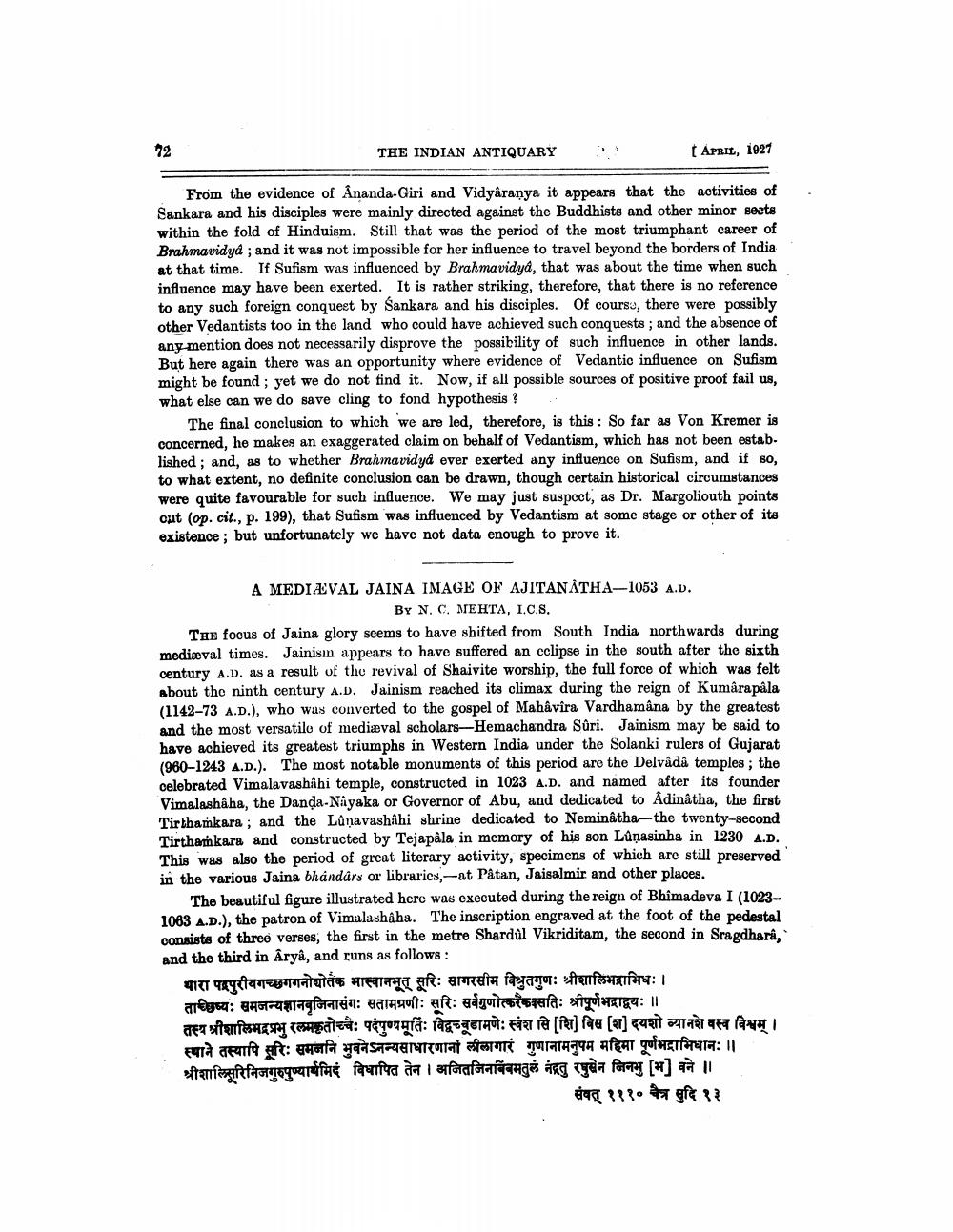________________
72
THE INDIAN ANTIQUARY
APRIL, 1927
From the evidence of Ananda-Giri and Vidyâranya it appears that the activities of Sankara and his disciples were mainly directed against the Buddhists and other minor sests within the fold of Hinduism. Still that was the period of the most triumphant career of Brahmavidyd ; and it was not impossible for her influence to travel beyond the borders of India at that time. If Sufism was influenced by Brahmavidya, that was about the time when such influence may have been exerted. It is rather striking, therefore, that there is no reference to any such foreign conquest by Sankara and his disciples. Of course, there were possibly other Vedantists too in the land who could have achieved such conquests; and the absence of any mention does not necessarily disprove the possibility of such influence in other lands. But here again there was an opportunity where evidence of Vedantic influence on Sufism might be found ; yet we do not find it. Now, if all possible sources of positive proof fail us, what else can we do save cling to fond hypothesis !
The final conclusion to which we are led, therefore, is this : So far as Von Kremer is concerned, he makes an exaggerated claim on behalf of Vedantism, which has not been estab. lished ; and, as to whether Brahmavidya ever exerted any influence on Sufism, and if so, to what extent, no definite conclusion can be drawn, though certain historical circumstances were quite favourable for such influence. We may just suspect, as Dr. Margoliouth points out (op. cit., p. 199), that Sufism was influenced by Vedantism at some stage or other of its existence; but unfortunately we have not data enough to prove it.
A MEDIAVAL JAINA IMAGE OF AJITANÅTHA-1053 A.D.
BY N. C. MEHTA, I.C.S. The focus of Jaina glory scems to have shifted from South India northwards during mediæval times. Jainism appears to have suffered an eclipse in the south after the sixth century A.D. as a result of the revival of Shaivite worship, the full force of which was felt about the ninth century A.D. Jainism reached its climax during the reign of Kumarapala (1142-73 A.D.), who was converted to the gospel of Mahavira Vardhamana by the greatest and the most versatilo of mediæval scholars-Hemachandra Sûri. Jainism may be said to have achieved its greatest triumphs in Western India under the Solanki rulers of Gujarat (960-1243 A.D.). The most notable monuments of this period are the Delvådâ temples; the celebrated Vimalavashîhi temple, constructed in 1023 A.D. and named after its founder Vimalashaha, the Danda-Nayaka or Governor of Abu, and dedicated to Adinatha, the first Tirthamkara, and the Lúnavashîhi shrine dedicated to Neminâtha-the twenty-second Tirthamkara and constructed by Tejapâla in memory of his son Lúnasinha in 1230 A.D. This was also the period of great literary activity, specimens of which are still preserved in the various Jaina bhandârs or librarics,--at Pâtan, Jaisalmir and other places.
The beautiful figure illustrated here was executed during the reign of Bhimadeva I (10231063 A.D.), the patron of Vimalashaha. The inscription engraved at the foot of the pedestal consists of three verses, the first in the metre Shardúl Vikriditam, the second in Sragdhara, and the third in Arya, and runs as follows:
पारा पदपुरीयगच्छगगनोयोतक भास्वानभूत् सूरिः सागरसीम विश्रुतगुणः श्रीशालिभद्राभिधः । ताच्छष्यः समजन्यज्ञानवृजिनासंगः सतामग्रणीः सरिः सर्वगुणोत्करैकवसतिः श्रीपूर्णभद्राद्वयः ॥ तस्य श्रीशालिभद्रप्रभुरलमकृतोच्चैः पदंपुण्यमूर्तिः विद्वच्चूडामणे: स्वंश सि [शि] विस [श] दयशो ब्यानशे वस्व विश्वम् । स्थाने तस्यापि सरिः समननि भुवनेऽनन्यसाधारणानां लीलागारं गुणानामनुपम महिमा पूर्णभदाभिधानः ।। श्रीशालिसरिनिजगुरुपुण्यार्थमिदं विधापित तेन । अजितजिनबिनमतुलं नंदतु रघुसेन जिनभु [भ] वने ॥
संवत् १११० चैत्र सुदि १३




